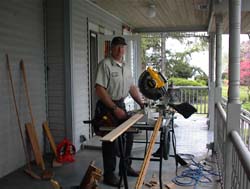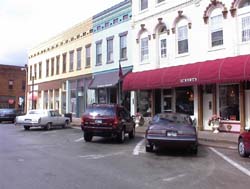|
Amid
baskets of spindles, stacks of boards and tools and equipment lining
the walls, he meticulously turns pieces of lumber into works of art.
His prized possession is a handmade carpenter’s box, modeled after
an 18th century design, which holds his woodworking tools.
Simpson,
who grew up in Oquawka, a Henderson County town on the Mississippi
River, said his specialized business is booming enough to keep him
busy 10 hours a day, six days a week.
“Local
business has depended entirely upon word of mouth, which is a slow
but sure foundation. It has taken about three years to build up to a
point where I have started to feel established,” he said.

[Simpson works diligently on his latest
project.]
But
despite his success and obvious talent, his interest in woodworking
was sparked more from necessity than career planning during his
early years in the Army.
“The
Army post had a craft shop for soldiers to use in their off-duty
time. Needing furniture and making only $289 a month, the interest
grew more out of need than recreation,” he said. He left the Army
to complete his college education, taking a sabbatical during his
junior year to work as an apprentice for a master cabinetmaker in
Virginia who specialized in 18th-century work. He also rented a
garage while earning a degree in industrial education from Western
Illinois University and built and repaired furniture for professors
on campus.

But
the skills he learned early in life would one day became a new
career. After moving from the state of Washington to Petersburg, he
moved to Lincoln in 1988 for a job transfer, then retired as an
Infantry Major in 1994. He spent the following year teaching
industrial arts for Peoria School District 150’s Youth Farm.
During the same time, he fulfilled a personal dream by purchasing,
moving and restoring the Walnut Grove School, which pre-dates the
Civil War and now sits next to his home.
It
was during his daily drives to his job at the Armory in Decatur that
he first spotted the schoolhouse. “One of my routes took me on
this blacktop, right by this schoolhouse. The more times I went by
it and the more I thought about it, the more it worked on me,” he
said. “It was surrounded on three sides by plowed fields. The side
porch had fallen off and it was falling in ruin. I thought ‘what a
shame,’ because I knew there couldn’t be many left. I wanted to
save it.”
Simpson
purchased the schoolhouse from its previous owner for $3,500. “The
owner just wanted what he had in the paint job. It was pretty
rough,” he said.
After
purchasing the home, Simpson tackled the job of restoring the
schoolhouse as much as possible before he moved it. “I would get
up at 4 a.m. and go to work. On the way home I would stop and work
on it till dark. I salvaged the 40-foot brick chimney, took out all
the wood trim, refinished it and put it back in. Then we moved it,
gutted the old plaster that was falling off, insulated it and
restored windows. I won’t allow any alterations upstairs or it
would lose its historical value,” he said.

The
non-standard schoolhouse was built before federal building
guidelines were instated. The 28-by-32-foot building originally had
a tornado shelter under the front porch, which Simpson also
recreated.
|

The
process of restoring the schoolhouse was not a piece of cake. After
completing much of the painstaking work and moving the structure, a
tornado ripped through the area, blowing three banks of windows out.
Simpson was out of town attending a family member’s funeral when
the disaster happened, but neighbors came to the rescue and placed
tarp over the vacant windows to prevent the interior from being
damaged.
Another
storm hit while the roof was being replaced, and Simpson worked
through the night, shoveling ice off the tarp-covered roof, in order
to save the original stamped-tin ceiling. The ceiling was
saved, but Simpson suffered a few broken ribs. Denny Uphoff, a
friend and neighbor, was involved in the restoration project every
step of the way.

Simpson’s
wife, Nancy, operated an antique and crafts business and tearoom out
of the school for a few years. However, they closed the business
after deciding it was taking too much time away from their three
children, and the school was empty for about a year until they
decided to rent it as a home.
“The
first time I advertised in the paper, I had five takers the first
night and 15 by the second night. No one ever walked away from it
saying they didn’t want to rent it,” he said. “The first
couple who rented it were both teachers and they loved it.”
Simpson
said the entire restoration project, which totaled about $70,000,
was well worth the effort. Even though during the time he was
restoring the building he wasn’t able to obtain any funding from
area historical associations, several have now expressed interest in
purchasing the school. “I let renters in it just to help defray
costs of the whole expedition, but I won’t make any alterations.
The city of Atlanta and Mount Pulaski have both approached me and
want to purchase it and move it to their communities. It is a finite
resource.”

[Hard at work in his shop.]
The
summer he worked on the schoolhouse, he also converted his barn to a
woodworking shop and became so busy he decided to do it full time
and not return to teaching. Now – many church altars, podiums,
custom furniture pieces, stair banisters and millwork jobs later –
he is enjoying his retirement by working full time.
He
is also currently involved in the restoration of a Victorian mansion
damaged by a tornado in Hamilton. One of his most involved jobs in
Lincoln is ongoing work on a local doctor’s restored Victorian
home on Tenth Street. The work includes replacing the pine baseboard
with oak trim, designing and replacing missing stairway pieces,
paneled, coved ceilings, new built-in cabinets and a custom-designed
hall tree.
The
former Lincoln scoutmaster is also an adult adviser for a living
history Explorer site operated at the Log Village on the Old
Threshers grounds in Mount Pleasant, Iowa. He also plays in a
Scottish bagpipe band and performs folk music for the Old Threshers
Reunion.
As
a child, he moved often because of his father’s occupation and has
lived in too many states to count. His traveling continued during
his tour with the army, and he has now lived in Lincoln longer than
any other place. But someday he hopes to finish restoring his own
house and return to his Hamilton County roots and build a house on
the river.
[Penny
Zimmerman-Wills]
|
|
In
April 1998 Steffens retired from Mitusbishi in Bloomington after
nine years, and he, his wife, Bette, and son and daughter-in-law, Jason
and Beth, purchased
adjacent buildings 121-123 on Sangamon Street. They renovated the nine apartments and opened Eckert’s Fine
Furnishings. Larry’s son Jon joined the corporation in December
1998 as a partner and chef, and they opened Eckert’s Fine Dining.
The restaurant serves gourmet, six-course French and Italian
fare. On May 1, the
corporation will open Grapes & Grounds, a café that will serve
imported coffee, wines and specialty beer.

[100 block of Sangamon Street (right to left):
Eckert's Fine Furishings, Eckert's Fine Dining, Grapes &
Grounds, Pluth Tin Shop and The Pink Shutter are
owned by the Steffens Corporation.]
Larry
Steffens first purchased the property on Sangamon Street as rental
property. His forte is
in the area of design, and he enjoys restoring old buildings.
Steffens and his wife, Bette, manage the design studio but
leave the day-to-day running of the corporation to their sons.
The Steffenses are in the process of creating a
4,000-square-foot penthouse above the Pink Shutter to be used
as their personal residence. Steffens
said this move will bring them closer to their business, their
children and their grandchildren.

Cooperation
and teamwork is Steffens’ mantra.
He fosters this belief by belonging to the Chamber of
Commerce, the Sangamon Street Block Association and others. He
says, “Things happen very quickly in numbers.”
Steffens organized the Sangamon Street Block Association, a group
comprised of Sangamon Street business owners, bankers, the mayor and
others interested in what’s going on Sangamon Street.
They meet every third Tuesday of the month at Eckert’s Fine
Dining in an open forum to talk about problem areas on Sangamon
Street.
“Lincoln
has a unique historic downtown area,” Steffens says. He sees
Lincoln developing into a tourist hub like Galena. He sees Lincoln
as “a destination, a place where people go to do something
different.” Steffens
commends the city council and the street commissioner for their
cooperation in making the development of Sangamon Street a lot
easier.

“The
goal is to make people feel welcome,” said Steffens.
The Steffenses pride themselves in offering people
hospitality and the use of their services even when some of their
more senior visitors only come into their shop to rest.
Steffens
wants to contribute to the revitalization of the downtown area.
“Lincoln has a lot to offer.
It has a great potential for commerce.
There are 1½ million people within a 50-mile radius.
We want these people to come to Lincoln to dine, shop and
stay for the night,” he continued.
His vision for Lincoln in the next 10 years is that it will
be a retail- and service-based city.
He wants Lincoln to become a weekend destination spot.
|

Two
of their 13 apartments on Sangamon Street will be renovated into
European-styled Bed and Breakfast suites within the next two years.
The suites will be available in packaged deals with and
without meals. The
corporation is already in negotiations with Amtrak to promote the Bed and Breakfast suites along Amtrak’s main corridor.
The
corporation also owns the 125 and 129 Sangamon St. buildings, the
current locations of the Pluth Tin Shop and the Pink Shutter
respectively. Within
the next two years, the Steffenses plan to extend their restaurant
into the Pluth Tin Shop. The
back two-thirds of the shop will be used as additional seating for
the restaurant and as a piano lounge that will feature jazz and blues.
Steffens hopes to have a long relationship with the Pink
Shutter. “They are good tenets, and they bring a lot of people
onto the block,” he said.

Three
years ago the corporation purchased 412 Pulaski, across from the
Vintage Fare restaurant and renovated the entire building.
They also purchased two properties at 519 and 521 Broadway
St., locations leased by Action Rental and Sorrento’s.
These facades are being refurbished with a renovation grant.

[Jon, Larry and Jason Steffens in
the Eckert's Fine Dining Restaurant]
One
of Steffens’ pet projects is his adoption and renovation of the
two parks in the 100 block of Sangamon Street next to the railroad
tracks. Americorp
volunteers, the railroad and the Sangamon Street Block
Association assisted with the project. Larry Steffens has financed
the addition of flowers, benches, sculptures and the weekly upkeep
of the parks. He
showcased his flare for design with the hand-painted mural on the
back wall of the Neal Tire building.

[100 block of Sangamon; Paul and Larry Steffens'
mural]
As
for the future, he says they will continue to look at buildings that
interest them in the downtown area. “My sons have a lot of energy
and are very ambitious. We
are not done by any means,” Steffens
concluded.
[Kym
C. Ammons-Scott]
|

